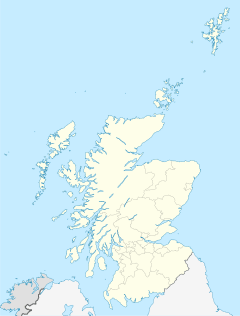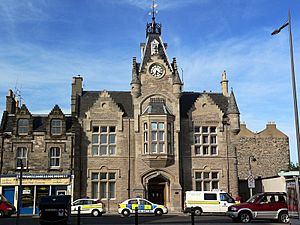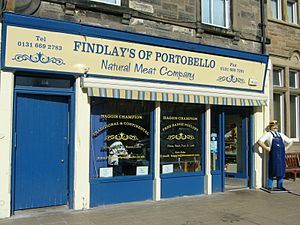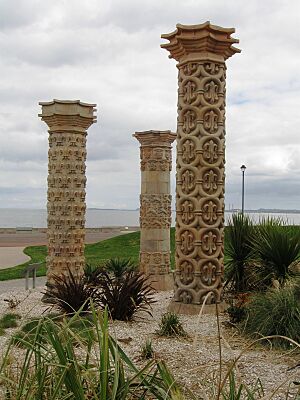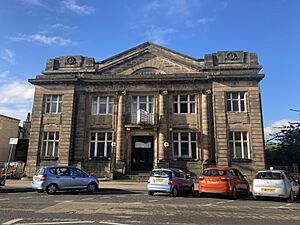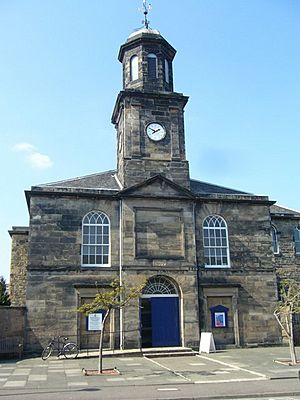Portobello, Edinburgh facts for kids
Quick facts for kids Portobello
|
|
|---|---|
| OS grid reference | NT304738 |
| Council area |
|
| Lieutenancy area |
|
| Country | Scotland |
| Sovereign state | United Kingdom |
| Post town | EDINBURGH |
| Postcode district | EH15 |
| Dialling code | 0131 |
| Ambulance | Scottish |
| EU Parliament | Scotland |
| UK Parliament |
|
| Scottish Parliament |
|
Portobello is a lively coastal area in Edinburgh, eastern central Scotland. It sits about 3 miles (5 km) east of the city centre. Portobello faces the Firth of Forth, which is an estuary, and is located between the areas of Joppa and Craigentinny. Even though it used to be a separate town, it is now officially a part of Edinburgh. A long walkway, called a promenade, runs along a wide, sandy beach.
Contents
Exploring Portobello's Past
How Portobello Got Its Name
This area was once known as Figgate Muir. It was a large open moorland where the Figgate Burn flowed into the sea. The name "Figgate" might have come from an old word meaning "cow's ditch." However, monks from Holyrood Abbey used the land to graze cattle. So, it more likely means "cow road," similar to Cowgate in Edinburgh.
In 1742, a sailor named George Hamilton built a small house here. He had served under Admiral Edward Vernon when they captured a place called Porto Bello in Panama in 1739. "Porto Bello" means "beautiful port." Hamilton named his house Portobello Hut to celebrate this victory. Over time, more houses were built around it, and the area became known as Portobello.
Early Days and Famous Visitors
In 1296, the Scottish hero William Wallace gathered his forces on the moor before the Battle of Dunbar. Later, in 1650, it's believed that Oliver Cromwell had a secret meeting with Scottish leaders here.
By the 1700s, Portobello was a popular spot for sailors and people involved in smuggling. In 1763, a man named William Jameson bought some land. He discovered a valuable type of clay and built a factory to make bricks and pottery. This helped Portobello grow into a busy village.
Walter Scott, a famous Scottish writer, used to practice drills with the Edinburgh Light Horse on Portobello Sands. In 1802, he was injured here and used his recovery time to finish his poem, The Lay of the Last Minstrel.
Portobello Becomes a Popular Resort
Portobello soon became a trendy place for people to visit for sea bathing. In 1807, new salt-water baths were built. In 1822, King George IV visited Scotland. As part of his visit, a review of troops and Highlanders was held on the sands, with many people watching from the sand dunes.
During the 1800s, Portobello also became an industrial town. Factories here made bricks, glass, paper, pottery, and more. In 1833, Portobello became a burgh, which is like an independent town. Then, in 1896, it officially became part of Edinburgh.
A large power station was built in 1934 at the west end of the beach. It operated until 1977 and was later taken down.
Fun and Leisure in Portobello
From 1846 to 1964, a railway station made it easy for visitors to come to Portobello. The town had many attractions, including a large outdoor heated swimming pool. The famous actor Sean Connery even worked there as a lifeguard! The pool used extra heat from the power station. It closed in 1979.
There was also a lido (another type of outdoor pool, now gone) and a permanent funfair, which closed in 2007. In 1901, the Portobello Baths opened on the Promenade. These baths, now called Portobello Swim Centre, are still open today. They are home to one of only three working Turkish baths in Scotland.
The Portobello Pier and Marine Gardens
Portobello Pier was a long pier that stretched out into the sea. It opened in 1871 and was 1,250 feet long, with a restaurant and an observatory at the end. It was designed by Sir Thomas Bouch. Sadly, the pier's iron supports rusted, and it was taken down in 1917 because it was too expensive to fix. The Promenade, the walkway along the beach, was built in 1876.
The Edinburgh Marine Gardens were built nearby in 1908–1909. They had an outdoor theatre, a ballroom, a scenic railway, and even a speedway track for races. These gardens were only open for about six years before World War I started. They never fully recovered and were eventually cleared away in 1966. Now, a bus depot and car showrooms are on that site.
Who Lives in Portobello?
Here's a look at the different groups of people who live in Portobello, compared to Edinburgh as a whole:
| Portobello compared | Portobello | Edinburgh |
|---|---|---|
| White | 92.6% | 91.7% |
| Asian | 4.8% | 5.5% |
| Black | 1.4% | 1.2% |
| Mixed | 0.7% | 0.9% |
| Other | 0.5% | 0.8% |
Getting Around Portobello
Buses
Lothian Buses provides many bus services to Portobello. Buses connect the area to Joppa, Musselburgh, Fort Kinnaird, and other parts of Edinburgh. Electric trams used to run here, but they were replaced by diesel buses in 1956.
Railway
Portobello had its first railway station in 1832. A newer station opened in 1846. However, this station closed in 1964 as part of the "Beeching cuts," which closed many railway lines across the UK.
Hovercraft
For two weeks in 2007, there was a trial hovercraft service from Portobello to Kirkcaldy in Fife. A company was interested in making it a regular service, but they couldn't get permission to build the necessary facilities.
Sports and Activities
The Promenade and beach are popular for sports. Two annual running races take place here: the Portobello Beach Race every summer since 2013, and the Promathom on most New Year's Days since 1987. Both races are about 4 miles (6.4 km) long.
Portobello's Town Halls
When Portobello was an independent burgh, it needed a town hall. The first purpose-built hall opened in 1862. It was later replaced in 1877 by a new building, which is now the Police Station.
When Portobello joined Edinburgh in 1896, a new, larger Portobello Town Hall was planned. It was designed to hold at least 800 people and opened in 1914.
In 2019, the town hall was closed because parts of the building were in poor condition. However, a local group called Portobello Central worked to reopen it. With funding from the Scottish Government, the Town Hall reopened on June 1, 2023. It is now run by the community for public meetings and events.
Famous People from Portobello
Many interesting people have connections to Portobello:
- Alexander Laing (1752–1823), an architect who lived and died in Portobello.
- Dr David Laing (1792–1878), a famous librarian and archaeologist.
- Hugh Miller (1802–1856), one of the first important geologists, lived in Tower Street.
- Helen Hopekirk (1856–1945), a composer, pianist, and teacher, lived on High Street.
- William Robertson (VC) (1865–1949), a recipient of the Victoria Cross, a very brave award.
- Harry Lauder (1870–1950), a famous music hall entertainer, was born here. A garden in his memory was opened in 1970.
- William Russell Flint (1880–1969), a well-known painter.
- Ned Barnie (1896–1983), the first Scot to swim the English Channel in 1950.
- Sean Connery (1930–2020), the famous actor, worked as a lifeguard at Portobello's outdoor pool.
- Gail Porter (born 1971), a TV presenter, grew up in Portobello.
- Ewen Bremner (born 1972), a film and TV actor, was born here.
- Shauna Macdonald (born 1981), an actress, grew up in Portobello.
- Emun Elliott (born 1983), an actor.
Important Buildings in Portobello
Buildings You Can Still See
- St John the Evangelist RC Church, Portobello
- Bellfield Community Centre (used to be a church)
- George Cinema
- Portobello Library
- Portobello Swim Centre (with the Turkish baths)
Buildings That Are Gone
- Portobello Open Air Pool
- Portobello Power Station
- Portobello Marine Gardens
- Portobello Railway Station
Portobello Parish Church
The Portobello Parish Church building was designed by William Sibbald and opened in 1810. It became a full independent church in 1861.
In 2017, the Church of Scotland sold the church building to the local community. It reopened in 2018 as the Bellfield community centre, serving the whole community.


